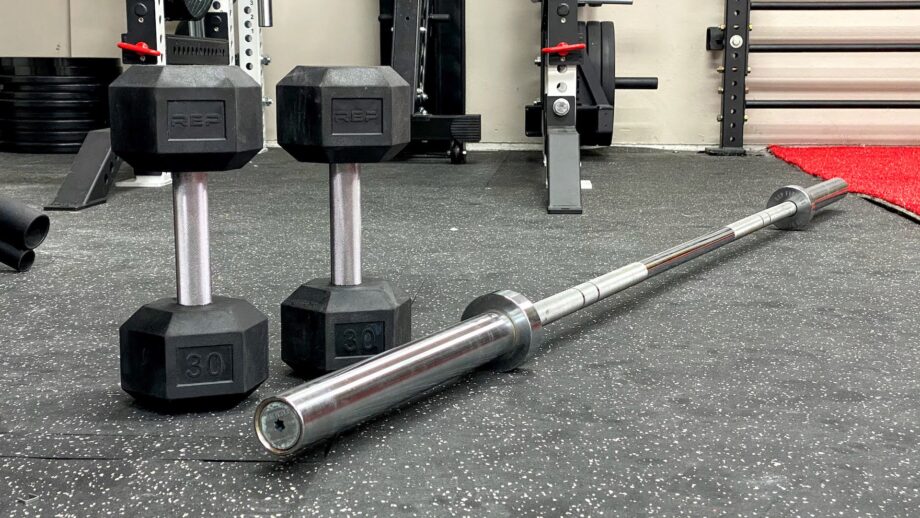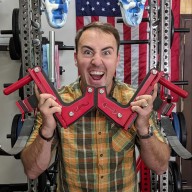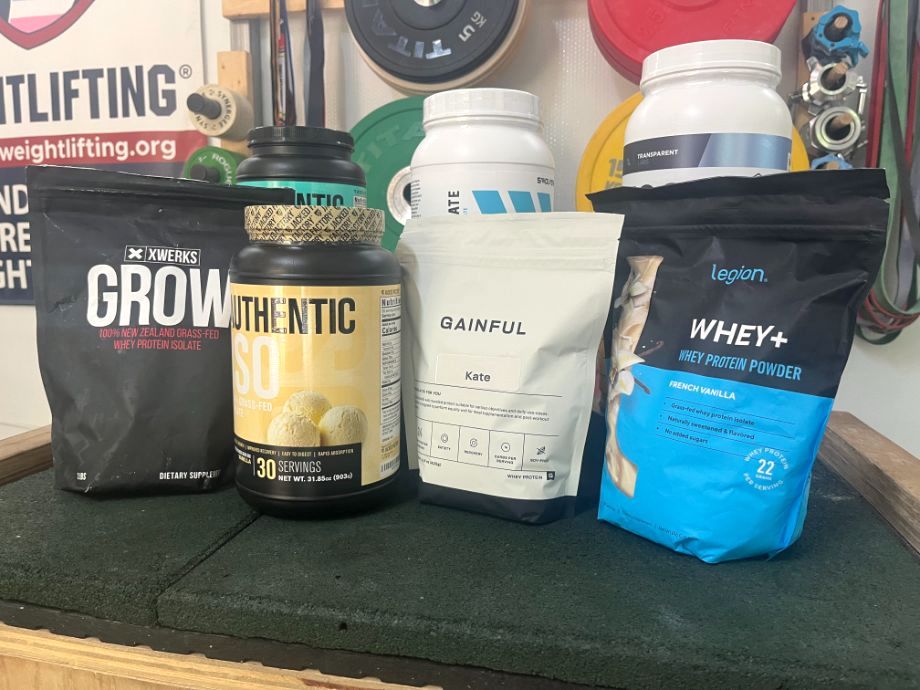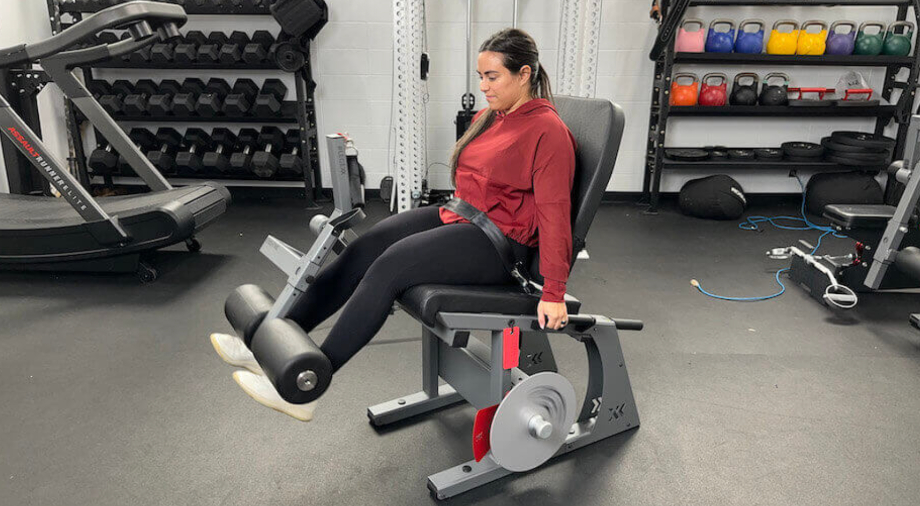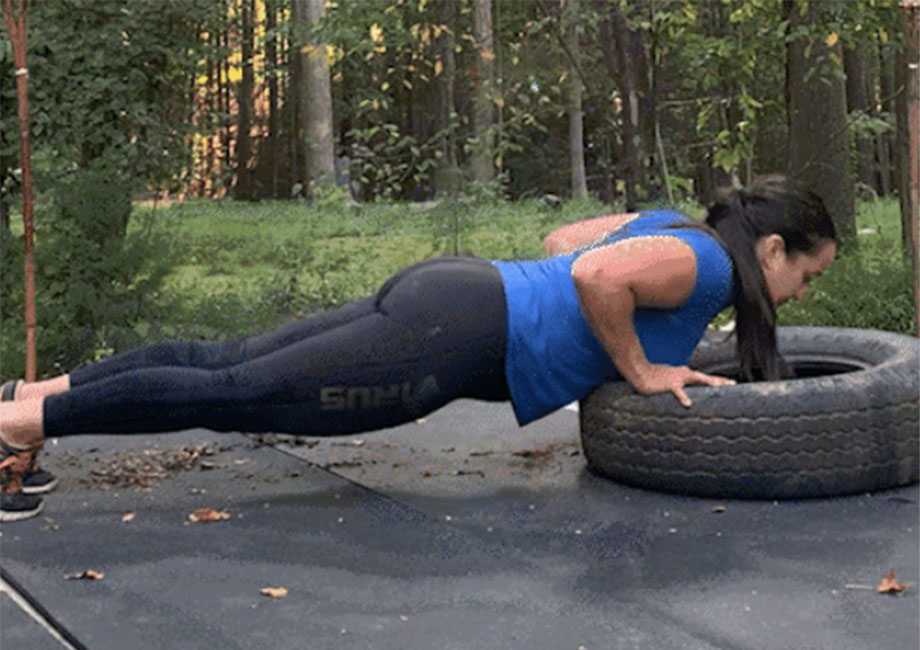The age-old debate: are barbells or dumbbells better for a home gym? What’s better for your workout? After using nearly every barbell on the market as well as most dumbbells and helping thousands of people start home gyms, I think we have a good idea on which is superior. Mostly, it comes down to your budget and training style–let’s discuss.
When building a home gym, one of the first purchasing decisions is, “should I buy a barbell or a set of dumbbells?” Ultimately, most gyms, whether a garage gym or somewhere else in the house will end up having both.
Both barbells and dumbbells are effective pieces of equipment and are, in my opinion, some of the best pieces of home gym equipment to have. Regardless of which you decide to go with, make sure you choose quality items so they’ll last and provide safety while working out.
Barbell and Dumbbell History
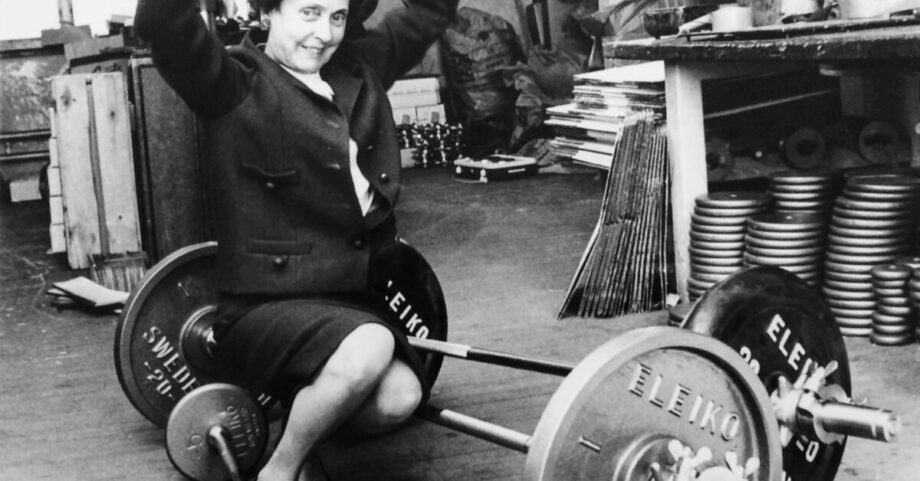
Ah, the age old question. Which is better overall for training – barbells or dumbbells? To better understand the discussion around this question (and which to include in your training) it may help to consider the history behind each piece of equipment.
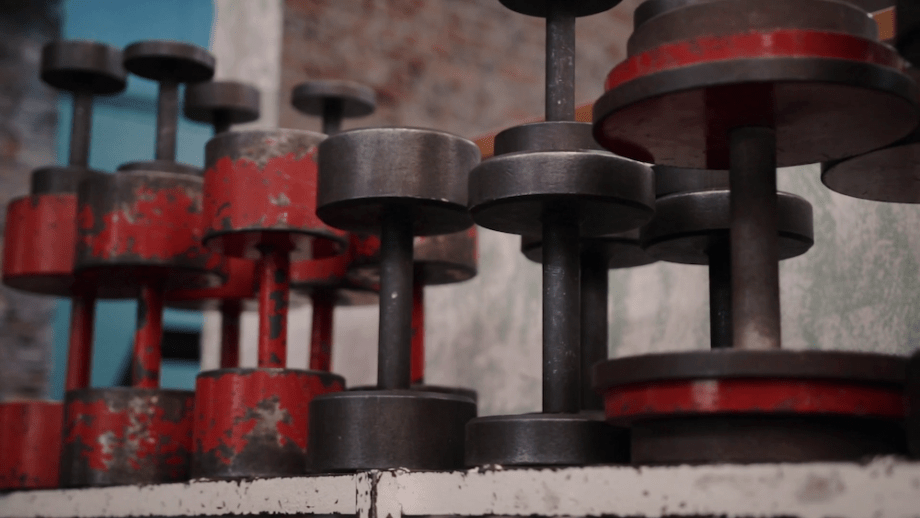
Dumbbells were invented first, dating back to 700 B.C. They were first used by the Greeks, specifically those who competed in long jumping. These long jumpers would use the strap on the handle of these crescent-shaped discs (halteres) to swing themselves back and forward, therefore creating the momentum to increase their jump. One thousand years later, those native to India used club-like metal rods (“nal” which many see as the inspiration for the Rogue Thompson Fat Bells) to increase muscle size and strength; they were typically used by sportsmen, wrestlers, and bodybuilders.
As for barbells, they are more of recent technology. There was little use, need, time, or desire to train heavy. Until the 19th century, athletes trained more so for agility and balance. According to Jan Todd, the first barbell was invented during the mid 19th century. Again, people during that time period had very little time or desire to train for longer periods of time. It is no coincidence that public gymnasiums and the barbell were invented around the same time period. Hearing the desire of American and European strongmen and strongwomen to become even stronger, Donald Walker created a prototype of the barbell (swinging club). However, this invention did not catch on.
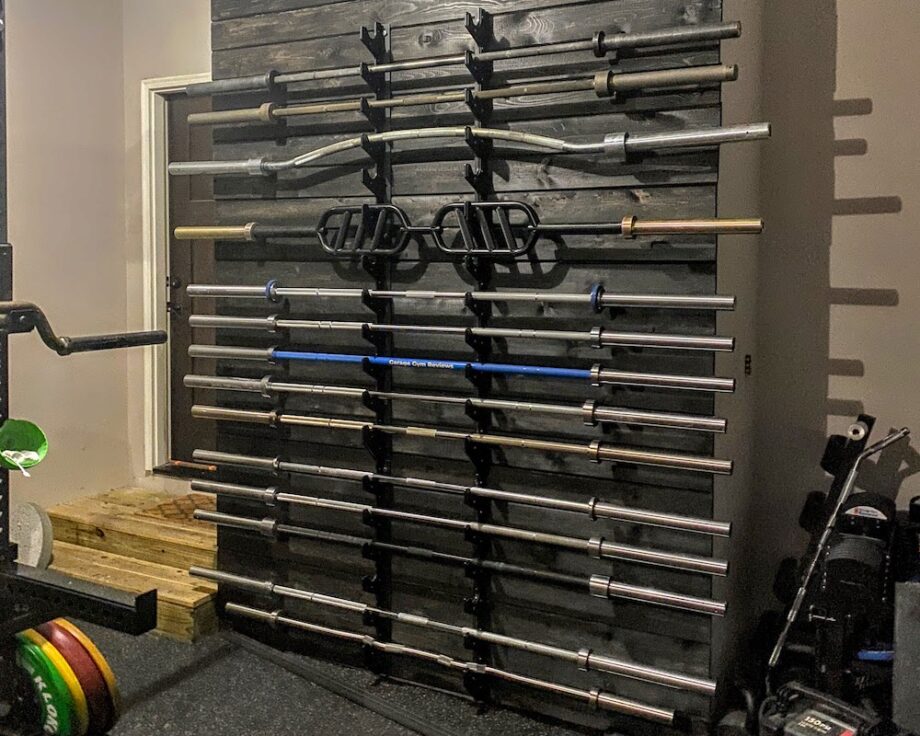
This barbell was modified and improved as time went on, but the barbell we all know and love today was crafted in the 1950s by Mr. Hellstrom. Hellstrom, a passionate weightlifter, became frustrated with how easily a loaded barbell could snap and break. Inspired by the waffle makers that Eleiko produced, Mr. Hellstrom worked on a steel-reinforced barbell. He approached his supervisors, who became enthralled by Hellstrom’s creation. In 1963, these bars were mass-produced and used in competitions all over the globe. Today, the Eleiko bar is still in us and loved by powerlifters, Olympic lifters, Crossfit athletes, and Strongmen.
Types of Barbells
Although the Olympic Barbell is almost synonymous with the word barbell, there are actually many different pieces of equipment that use the term.
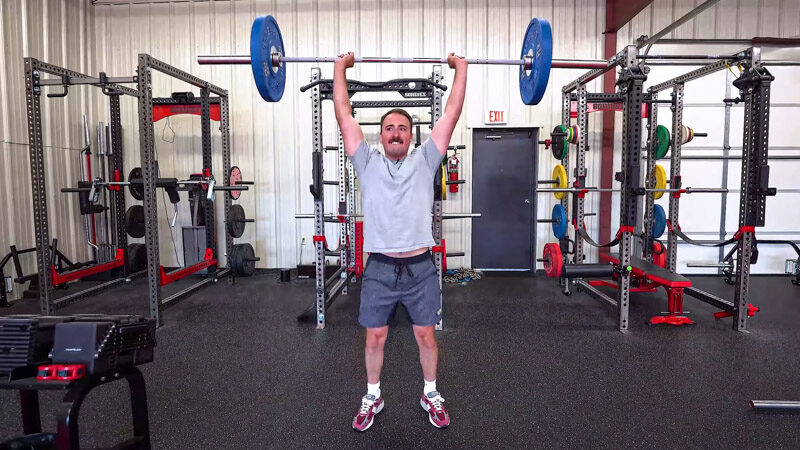
Olympic Barbells
If you have visited a commercial gym, box, or powerlifting gym, you have most likely lifted with an Olympic barbell (you can find my picks for the best Olympic barbells here.) The major difference between an Olympic bar and a standard barbell is that Olympic bars are 2’’ in diameter (meaning they can load more plates than a standard bar), are typically 7ft in length, and weigh, on average, 44-45lbs.
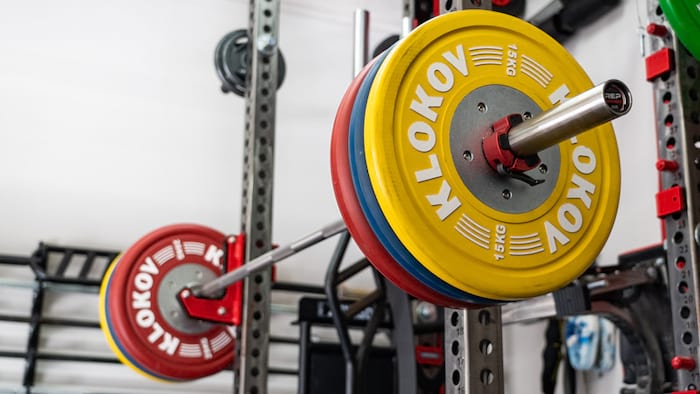
These bars are ideal for lifting, especially for heavy lifts; they can hold, on average, upwards of 750lbs. The “sleeves” (or arms) of the bar rotate, so they move with you as you lift, creating proper stability (which is important if you’re attempting a 1 rep max). Not only are they mobile, but these bars fit standard squat or power racks, meaning they are easily rackable.
However, many beginners who start strength training may struggle lifting a 44-45lb barbell. There is one solution: Rogue carries the Bella Bar ($215) and Women’s Training Bar ($275), which weigh about 15kg/33lbs and are thinner in diameter. These bars would be perfect if you have smaller hands and struggle wrapping your hands around the bar. They are also a little shorter at 6.59 feet but are still rackable. The only downside is that the sleeves are shorter, meaning they can hold less weight than a standard bar.
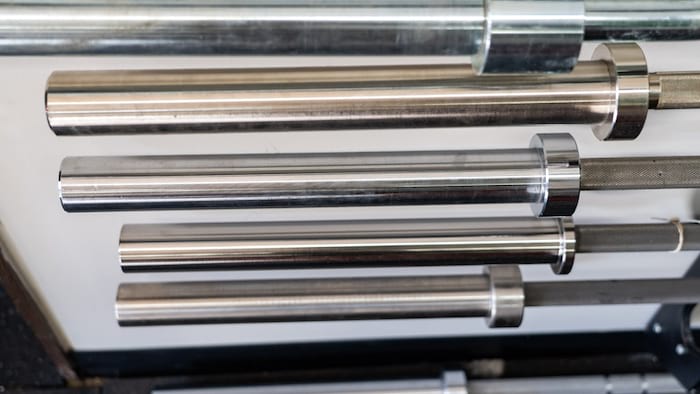
A traditional Olympic bar is about 7ft long, so if you train in an apartment or a small room, the barbell may just be too long. If you are a beginner, cannot lift 33-45lbs, and train in a small area, then a standard barbell may be your best bet.
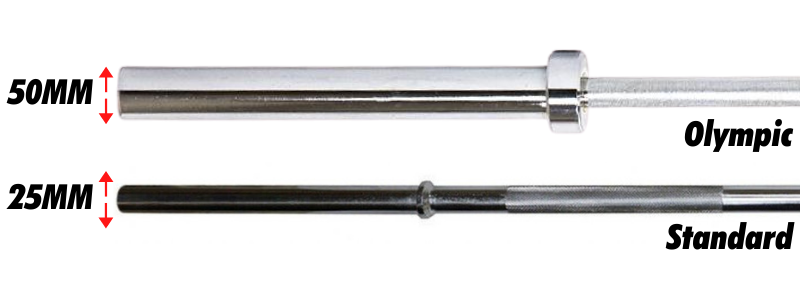
The Standard Barbell
The standard barbell is 1” in diameter, about 5ft long, and weighs 15-20lbs. When shopping for a standard bar it is important to note that you purchase a bar from a reputable source – buy a bar that is solid all the way through. Buyer beware of hollow bars, they are quite flimsy and can snap/break.
A standard bar is an okay choice for a beginner because they are so much lighter than an Olympic bar. However, due to the sleeve size, finding plates will be difficult (see best bumper plates here). One benefit though is that with only a length of 5ft, they can be used in a small room or apartment, easily. Remember: these bars will NOT be able to be placed in a traditional power or squat rack. The bar also does not move with you (the sleeves don’t rotate) and can only hold 200-300lbs max. If you plan on training heavy, this bar will not cut it down the road; it will snap and break.
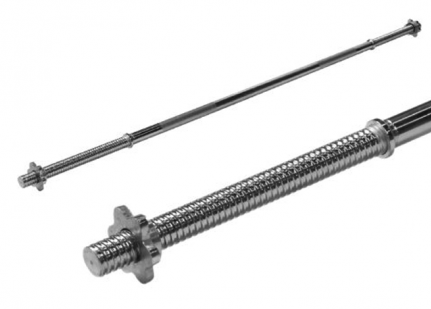
On a positive note, these bars are much cheaper than an Olympic bar due to their lighter construction.
If you aren’t using this bar to train squats or Olympic lifts, don’t plan on competing, are just getting started (or have new clients who’ve never trained before), and don’t care that it isn’t rackable, a standard bar may be for you, although we really would suggest saving money for an Olympic bar.
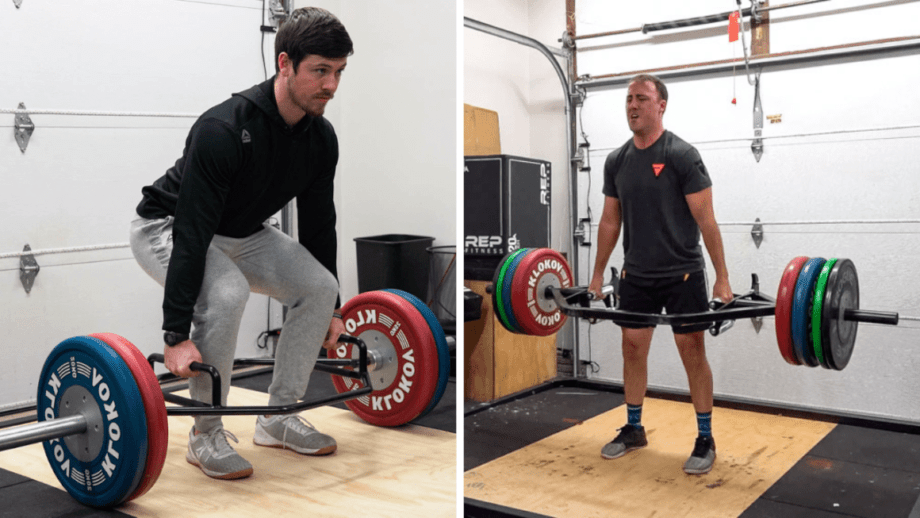
The Trap Bar
Seen across commercial and independent gyms alike, the trap bar is a hexagonal-shaped bar with two sleeves and two handles. These bars are typically used for deadlifts, an accessory to deadlifts (you can do wide, feet close, or feet together stance), or used for shrugs. A trap bar is also a great option if you are recovering from a back injury and still want to train deadlifts; I had a recurring hip flexor strain and this bar became crucial for my powerlifting training.
If you want a calibrated bar, Rogue ($375), Titan ($119), and if you’re willing to pay some serious cash, Kabuki’s new Trap Bar HD ($649) is a great choice. The weight of the bar varies from each manufacturer, so check the specs of the bar before you buy. Some bars are also rackable, so that is important to look for as well. If you’re not picky, Amazon does carry a trap bar by CAP that can often be had for around $50.
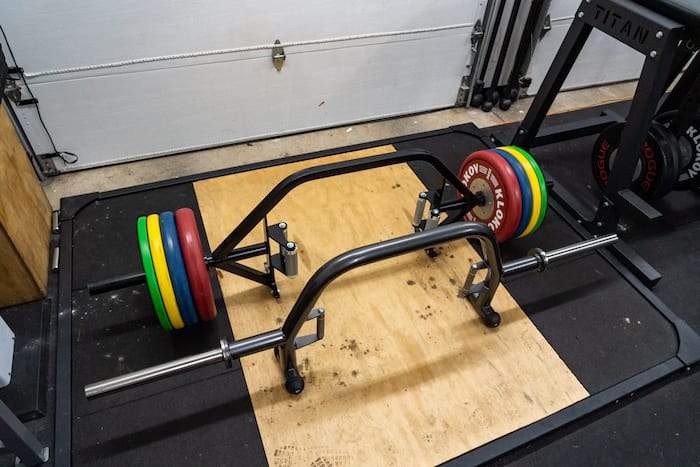
These bars do not have any flex, whip, and the sleeves are stationary, meaning that deadlifts feel solid. You will not feel any “give” with this bar. The knurling on the handles is also aggressive to ensure grip. Those with sensitive hands, weak grip, or those who want to avoid calluses, chalk, or straps will help you out.
You can find our guide to the best trap bars here.
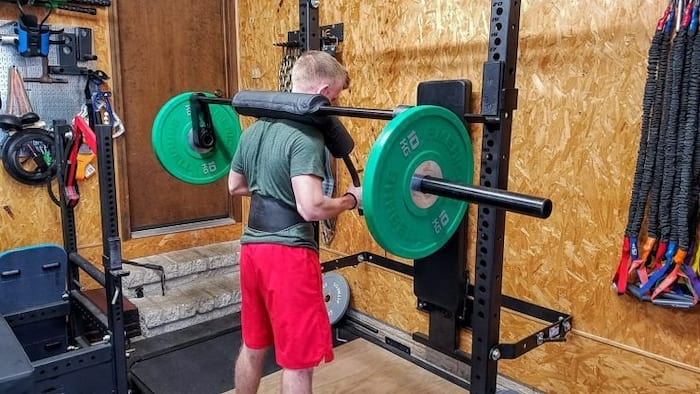
Safety Squat Bar
For those who have mobility or shoulder issues, a safety squat bar may be worth the investment. These bars sit in a high position (much like a high bar squat) and lessen pressure on the lower back. Another added benefit is increased mobility in the knees, hips, and ankles. The bar resembles a traditional barbell (yes, it is rackable) but with two stark differences – there is a padded harness on the front that sits on your shoulders, back, and upper arms. Most safety squat bars have handles that can be easily gripped that are at the end of each pad, making a squat more stable, comfortable, and easier to complete.
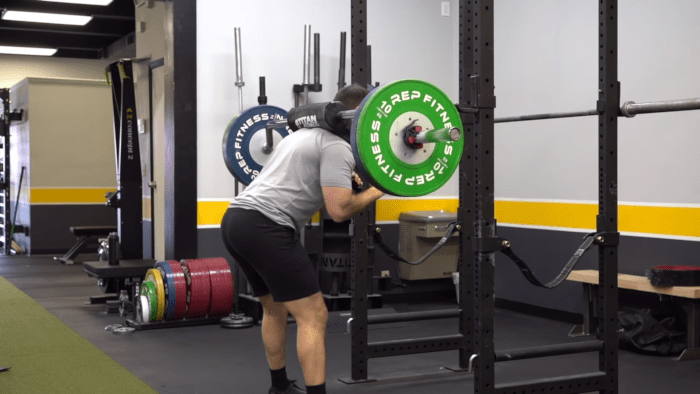
As for the number of exercises, you could complete with this bar – the possibilities are endless. They are incredibly useful and it is no wonder that it was invented by powerlifters. Some popular exercises are the front squat, back squat, Zercher squat, good mornings, lunges, hip thrusts, and more.
Some popular sellers are: Rogue ($395), Titan ($229), EliteFTS ($425), and Kabuki’s Transformer bar ($599). It may be a good idea to read reviews and specs before you buy to decide which bar is right for you.
You can find the best safety squat bars here.
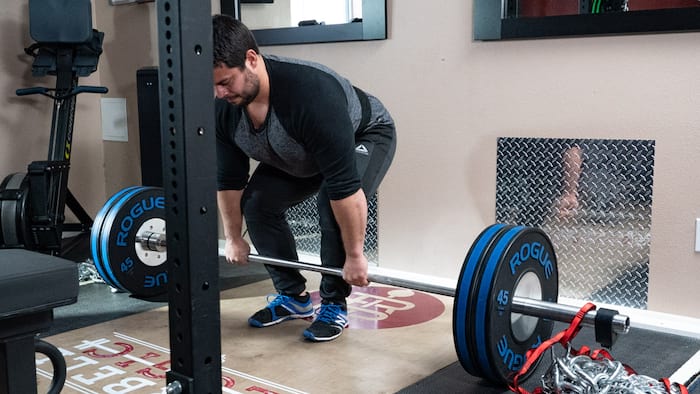
Deadlift Bar
Much like an Olympic Barbell, deadlift bars are built to withstand heavy lifts. Deadlift bars are a great purchase if you plan on competing and want to vastly improve your deadlifts. These bars are smaller in diameter, have more whip/flex than a traditional Olympic bar, and have aggressive knurling to ensure proper grip.
The price of these bars vary, but most are around $300, such as the Rogue Ohio Deadlift Bar.
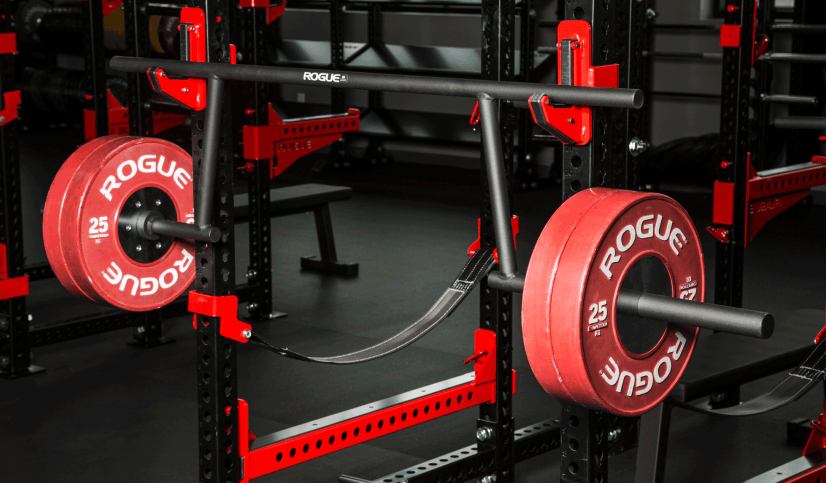
Camber Bar
These bars resemble a safety squat bar except there isn’t padding. These bars will definitely challenge and work your posterior chain and are traditionally used in powerlifting training. They are 1.5” in diameter, are rackable, and their weight can vary depending on the manufacturer (I’ve seen bars weigh anywhere from 85-105lbs), so they may not be suited for beginners. These bars allow the squatter to remain vertical, encouraging proper form, and allowing the lifter to train their explosiveness/full range of motion. As an accessory, these bars would be helpful for those who have limited mobility (especially shoulder injuries) or want a challenge mixed into their training.
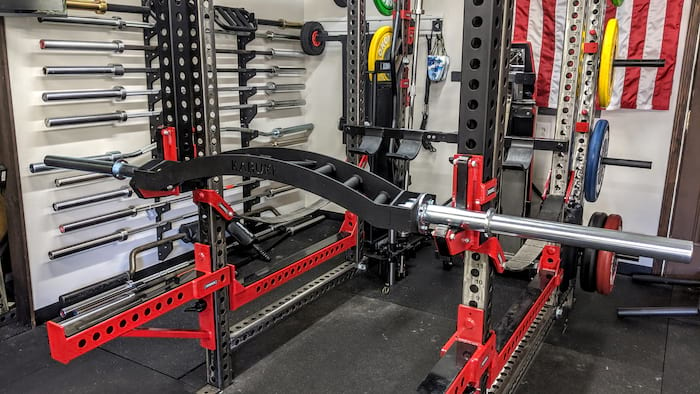
Multi-Grip Bar
Perfect for reducing the stress on your shoulders and wrists during pressing movements, a multi-grip bar is traditionally used for benching or overhead press work (see best weight benches). The multiple handles on the inside of the bar allow varied grip which can target specific muscle groups. These bars are similar in weight to an Olympic barbell (39-44lbs) and are about the same length as well, meaning they are rackable.
Our favorite multi-grip bar is the Kabuki Strength Kadillac Bar, although it is pretty pricey.
Types of Dumbbells
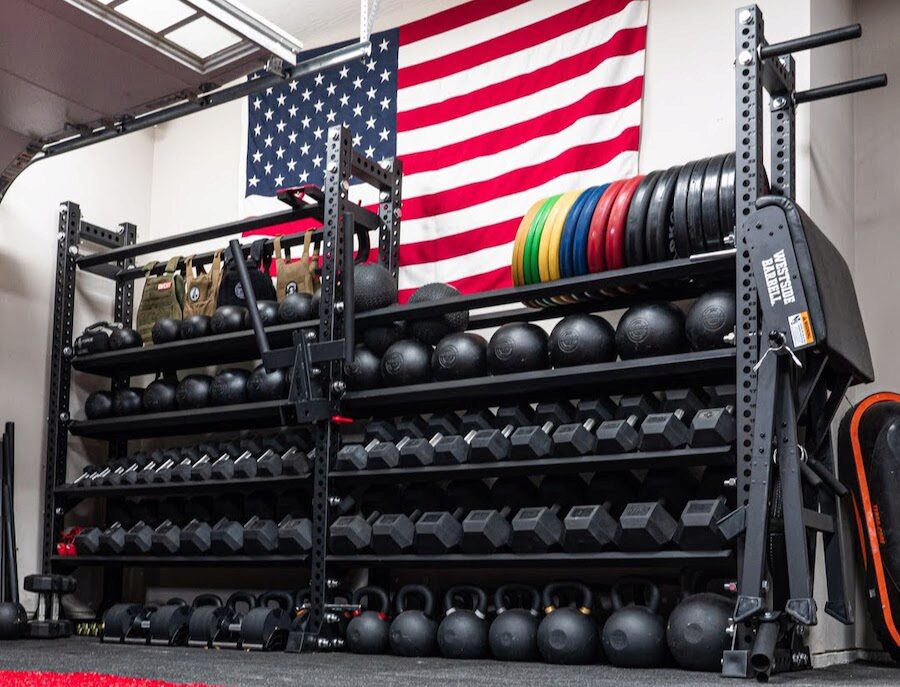
In a similar vein as barbells, dumbbells come in a variety of forms and capabilities. The important part is finding what works best for you and your budget. Depending on the size of your home gym as well as your training style, the type of dumbbell you choose will change.
For instance, bodybuilders use dumbbells a lot as they’re doing quite a bit of isolation work. So, having dumbbells in 5 lb increments in a wide range is important. If you’re an Olympic Weightlifter or powerlifter, dumbbells are less important.
If you are looking for budget-friendly dumbbells, check out my review on the best budget home equipment.
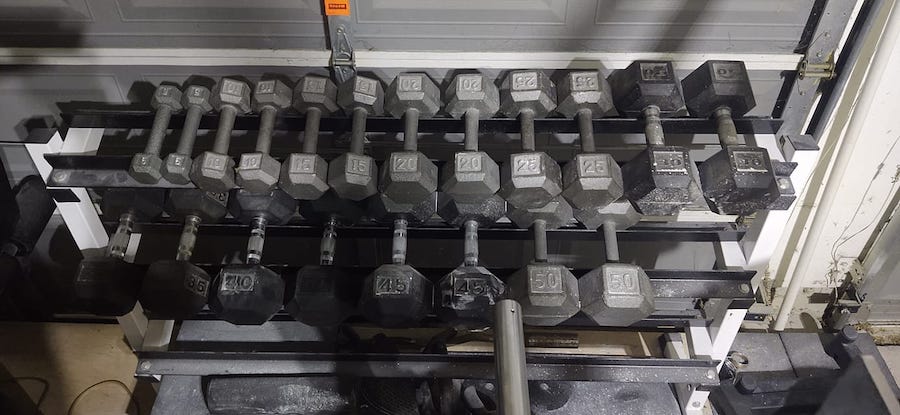
Hex Head Iron Dumbbells
Hex head dumbbells are what you traditionally see in independent/powerlifting gyms. They are constructed of one iron piece and have a hexagonal head on both ends. The poundage is clearly labeled on each end. These dumbbells can range anywhere from 2.5lbs to 150lbs, go up in 2.5lb, 5lb, and 10lb increments, and the cost varies on material used, weight, and producer. Due to their hex-heads, they do not roll, which is great for any floor or bench work.
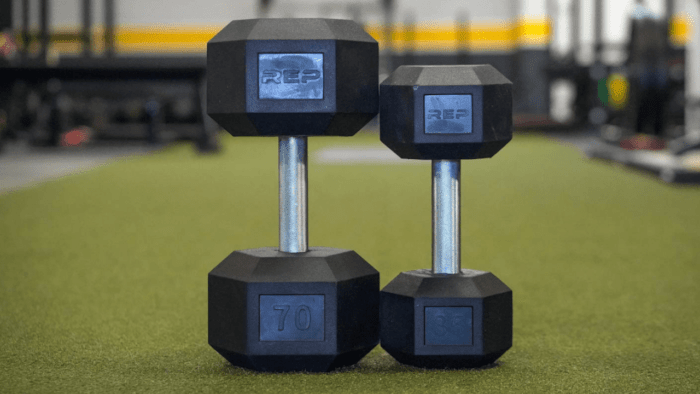
Just like their iron brothers, rubber hex head dumbbells have a similar shape, come in a variety of weights, and are traditionally used in commercial gyms. The only difference is that the handle of these dumbbells is often curved unless you go with the REP Fitness Rubber Coated Hex Head Dumbbells which use a straight handle. The rubber head when dropped will also leave less damage than one with an iron head. Also, if you accidentally trip or hit yourself with a rubber hex head dumbbell, it will hurt a lot less than iron-to-skin contact.
One note on rubber hex head dumbbells: they’re pretty much all the exact same. So, get the ones that offer the best price and warranty.
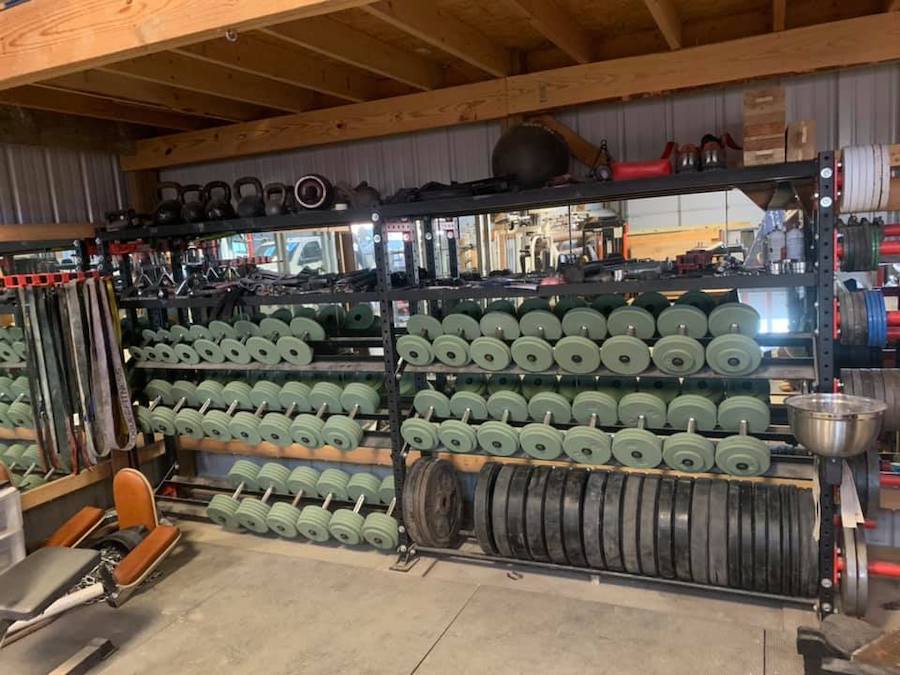
Pro-Style Dumbbells
A huge benefit of pro-style dumbbells is that you can assemble them yourself with your own weight plates (useful if you only want to go up by a few kgs or a half-pound). The handles of these dumbbells vary in length, weight, and are customizable. However, if you are looking for an adjustable dumbbell, these are not it. These dumbbells are meant to be assembled and then kept together. You CAN take them apart, but it is a pain to do so. The most popular pro-style dumbbells are from Ivanko, Troy, and York although there are others that make them.
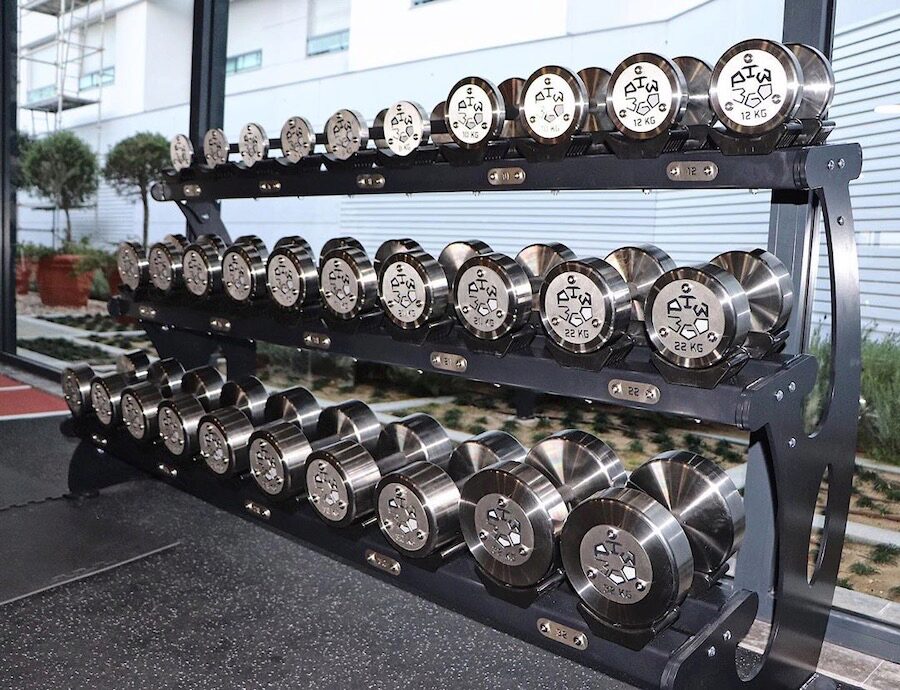
Watson Rotating Dumbbells
Some dumbbell enthusiasts call these the “Cadillac” of the dumbbell world. These dumbbells are not cheap ($6,210 for a set of 10lb-100lb weights), but have been reviewed as an absolute pleasure to use. The 2” handle is comfortable and rotates with your wrist – meaning you can firmly grip each dumbbell without worrying about wrist pain. Also, these dumbbells are customizable. If you are a gym owner or personal trainer, you can add your logo to the endplates. The highest weight produced is 300lbs, which is almost unheard of in a dumbbell, although they say they can make them as heavy as you’d like and are willing to spend.
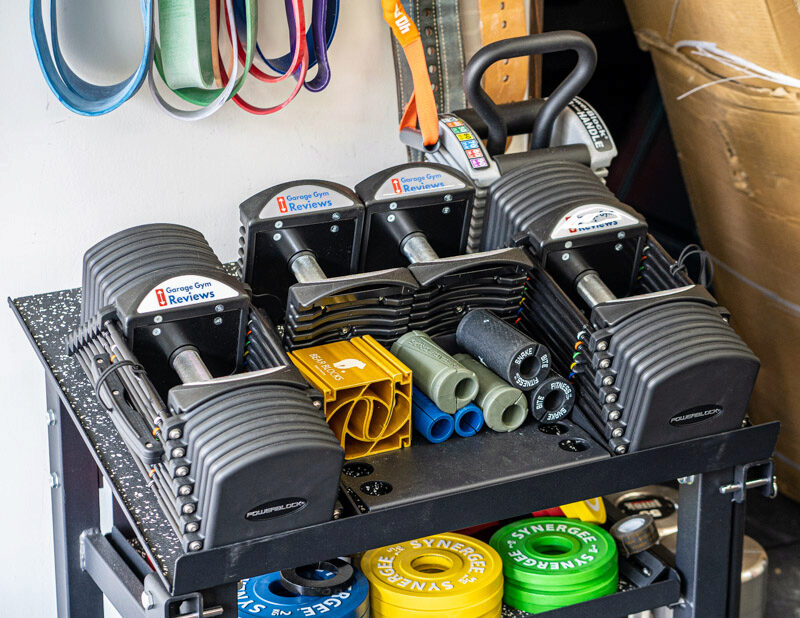
Adjustable Dumbbells
A great way to save some money and space, adjustable dumbbells are a great addition to a home gym. Check out the Powerblock adjustable dumbbells that I have reviewed – Pro, Sport, and Elite. The differences between the three are how much weight they can adjust to (Sport and Elite go up to 50, whereas the commercial Pro model can expand to 175lbs ) and also the length of each dumbbell. It is interesting to note you can buy expansions for the Sport and Elite models, but they cost an additional $129-149 depending on the model. From personal experience, these dumbbells are great, but can be annoying to adjust (sometimes the adjustment lever “sticks” or won’t sit right) and they can feel a bit clunky. They are also a bit bulky for smaller lifters/smaller hands, but overall, are a great money/space saver.
There are many companies worth looking at including these Bowflex dumbbells (great value,) Ironmaster (they go heavy,) and NUOBELLS (quickest weight change system we’ve tested.)
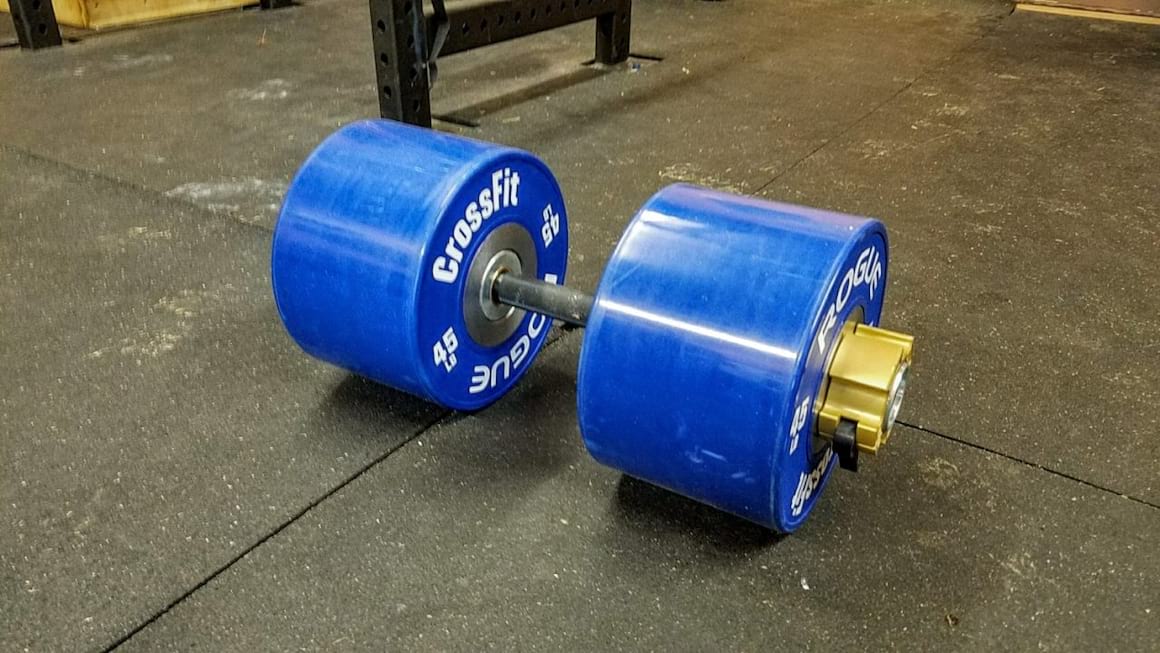
Loadable Dumbbells
Fully customizable, loadable dumbbells are the cheapest option for most. These are essentially mini barbells with shorter Olympic sleeves and can use the same weight plates you use on your barbell.
There are definitely specific plates like the Rogue Dumbbell Bumpers that are made specifically for loadable dumbbells, but most often, you should just use the 10’s and 5’s you already have. The great thing about loadable dumbbells is that you can get them as heavy as you’d like. I made a 150 LB dumbbell with a bunch of spare change plates for bent-over dumbbell rows one time. That’s something that simply can’t be done with other dumbbells.
Barbell vs Dumbbell
Choosing between barbells vs dumbbells is like choosing between dumbells vs kettlebells, it comes down to your workouts preferences. Barbells are best for completing fewer sets with heavier weights, and they are better for progressive overload. Dumbbells are better for building muscle and endurance with more reps.
Your decision may also come down to budget or spacing decisions. An entire dumbbell set can end costing more and taking up more space than a barbell will.
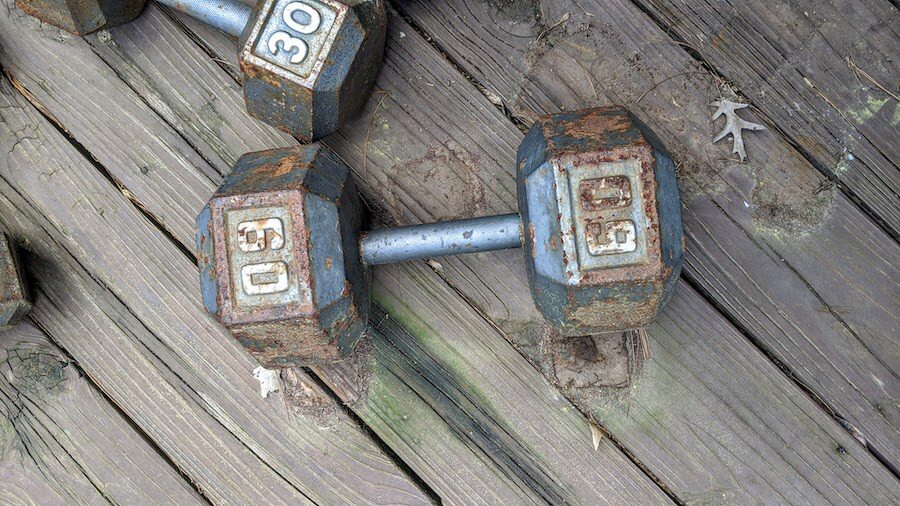
When looking at both of these pieces of equipment side by side, you could easily tell the difference between a dumbbell and a barbell. Dumbbells are smaller, have a short handle in the middle, and are preloaded with a specific weight. Obviously, you could purchase a loadable dumbbell, but the experience of the individual weight plates shifting can feel clunky and uncomfortable.
However, if you are looking at stability training or accessories to aid in “the big 3”, then dumbbells are incredibly useful to use. For example, pressing a dumbbell in each hand during a chest press will feel unstable, but will improve how you respond to a heavy bench press.
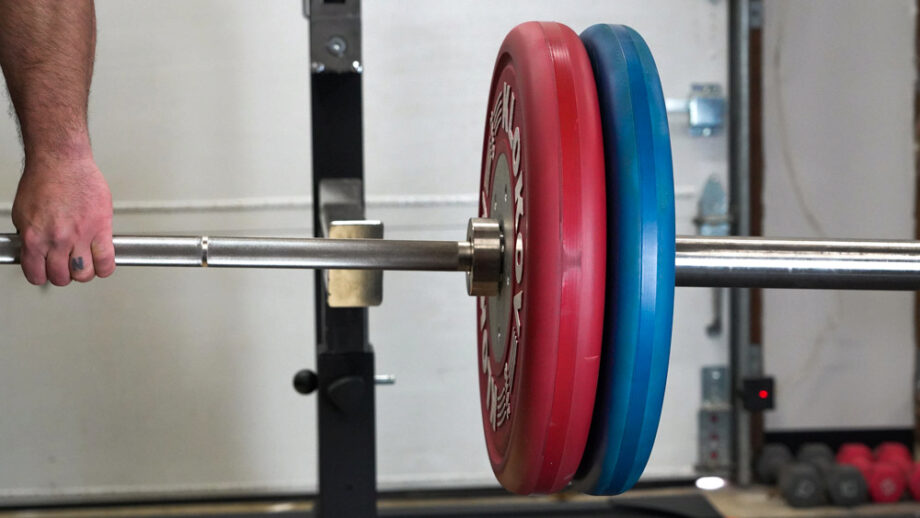
On the other hand, barbells are long metal rods with a “sleeve” at each end. Barbells can handle a lot more weight than a standard or loadable dumbbell, making them a better asset to improve or increase overall strength. There is nothing quite like the feeling of a bar in your hands, too, especially when pulling a 1rm off the floor!
From a price point, a barbell and some plates are going to be a lot less inexpensive than buying a set of dumbbells or loadable dumbbells (remember the set of Watson dumbbells I talked about above?). Overall, it all depends on the type of training you would like to do and your overall goals, so pick what is best for you.
What We Like About Dumbbells
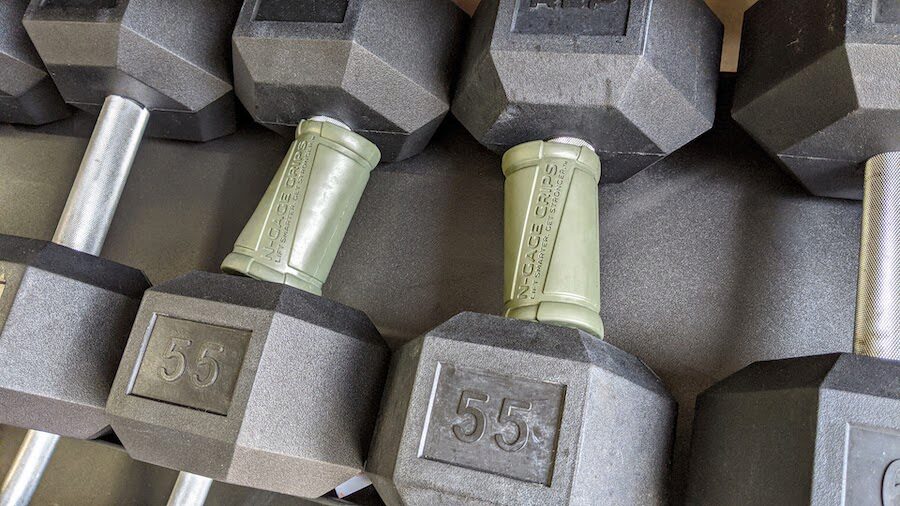
There are many reasons why athletes love dumbbells. It is incredibly easy to walk up to a rack or tower and pull a specific weight off of a shelf and start working. Unless you’re setting up a loadable dumbbell, they are quick and easy to use, and you won’t waste time during your workout to load or think about loading weight (I swear, calculating the amount of weight on a bar during a workout is more difficult than basic math). If you solely do a workout with dumbbells, it will take you a lot less time than one that is solely barbell-based.
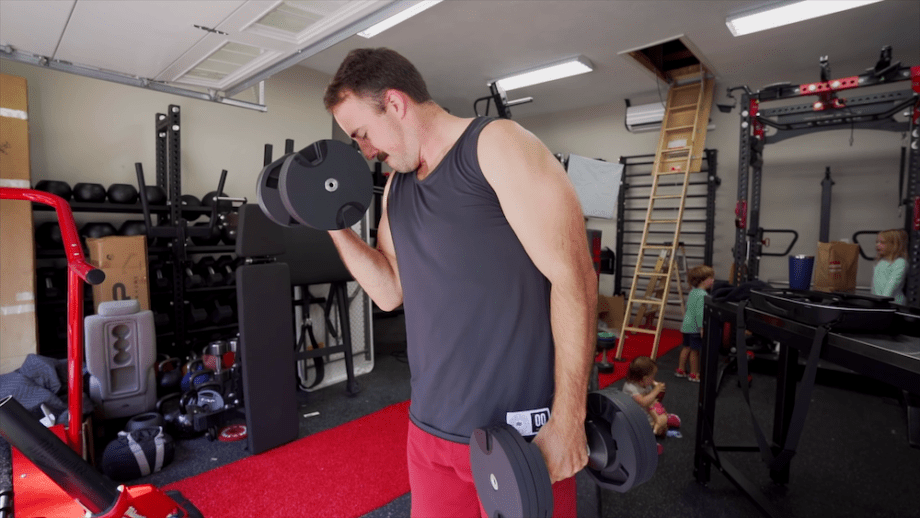
Dumbbells are second to none when it comes to accessory work. The handle and the size of each plate on each end make them incredibly accessible; you can move and place them to target all muscle groups. For example, When completing a chest press, you will get more ROM (range of motion) out of two dumbbells compared to a barbell. Unilateral work happens on its own as well; you cannot easily compensate for a weaker area, if there are 45lbs in each hand, they will be forced to carry that weight, whereas a barbell can lead to other muscle groups taking over for a lift.
Dumbbells make hypertrophy, supersets, and conditioning workouts a breeze due to their simplicity. To be honest, I love using them for time over tension work and to target specific muscles. Dumbbells tend to be easier on the joints as well (less weight, less pressure/stress) Also, if you have limited mobility in some areas, you can use a dumbbell to work a specific area, which is incredibly useful in rehabilitation work.
Why We Think a Barbell is Better Than Dumbbells for Most Home Gyms
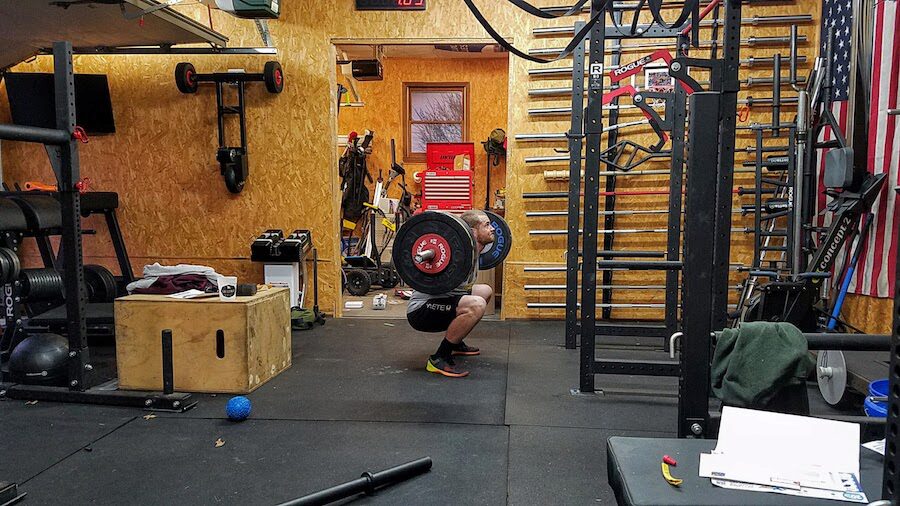
That all being said about dumbbells, there is no question or doubt in our minds about which is better – the barbell is the king of the gym.
Looking back on my training, I will say the greatest improvements that came (and are still happening) to my own strength and physique were underneath a bar. Sure, dumbbells helped to isolate certain muscles and make the main three lifts for me easier, but if my house was on fire and I could only salvage one thing, it would be my barbell.
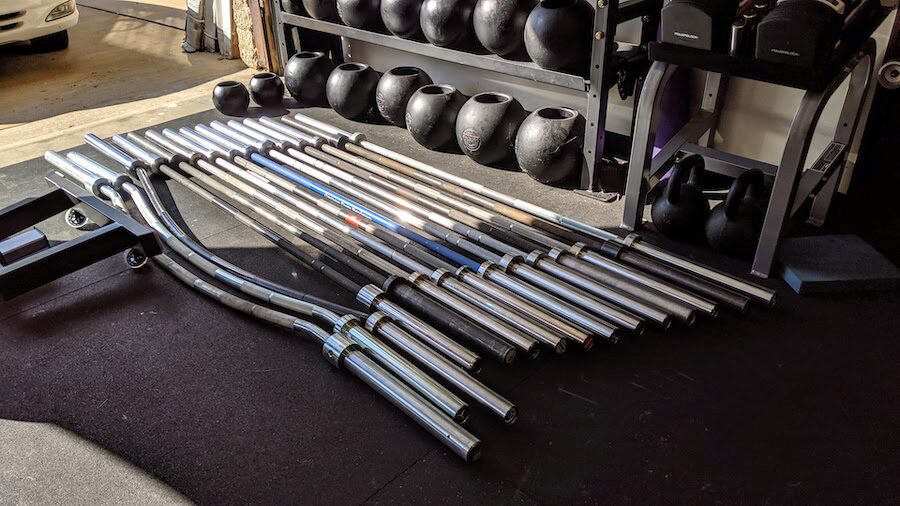
This isn’t the first time I’ve discussed barbells being superior to dumbbells. For Mark Rippetoe at Starting Strength I wrote an article titled, “Why The Barbell is King” because, well, it is.
Just thinking solely from an exercise perspective, one could definitely do more meaningful work with a barbell and a set of plates. As you become stronger, you can simply add weight to the bar. There’s nothing like squatting or deadlifting a little over 3 times your body weight and feeling that sense of accomplishment (one of the many reasons why I’m a powerlifter). If you’re a personal trainer, coach, or just a great person and want to spot for someone else, a barbell is much easier (and more predictable) to spot than a pair of dumbbells. Your body will improve too – heavyweight lifted consistently will build muscle, therefore increasing your metabolism. The more weight you lift, the better you will look (and feel).
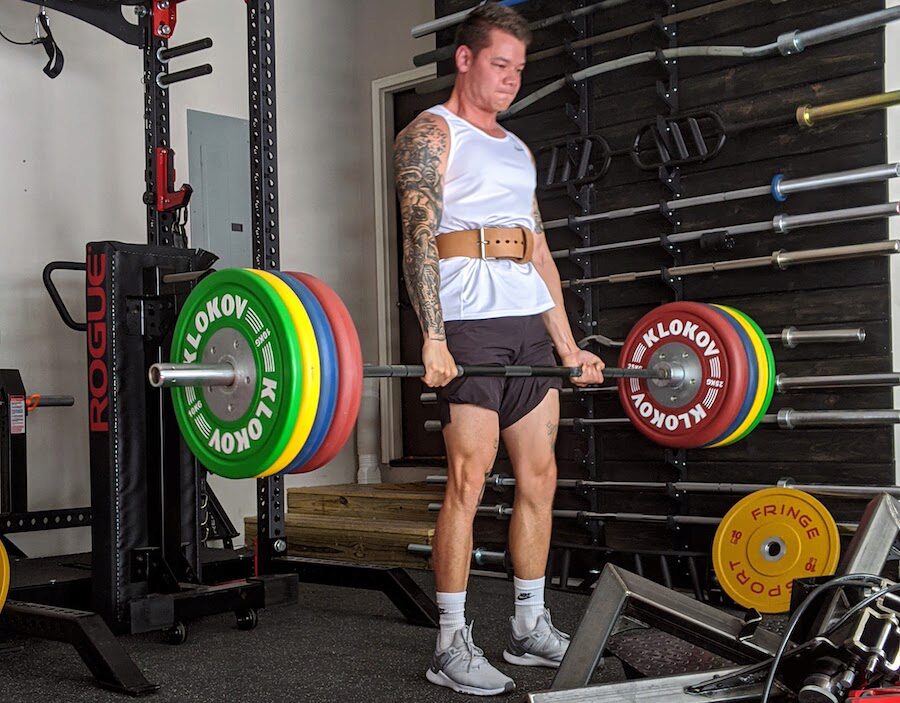
From a financial standpoint, it just makes sense to buy a barbell and plates. A decent bar and a set of plates will cost anywhere from $400-500 dollars, especially if you buy used (make sure you’re paying a fair amount, though). A set of dumbbells, especially as you increase in strength, could be thousands of dollars. Even a pair of Powerblocks are not cheap ($300-500) and the cheapest models only go up to 50lbs (the expansions are costly), but can always check out Powerblock coupons.
Without any doubt, the barbell has been the most sought for and bought a piece of gym equipment for all home gym owners. Since its creation, it has been used by strongmen, bodybuilders, powerlifters, CrossFitters, and athletes. There isn’t any other piece of equipment on the market that can outdo the work a loaded barbell could do. Barbells are the workhorses of gym equipment – they last forever and can be used by beginners and advanced athletes alike.
Barbell Exercise Movements
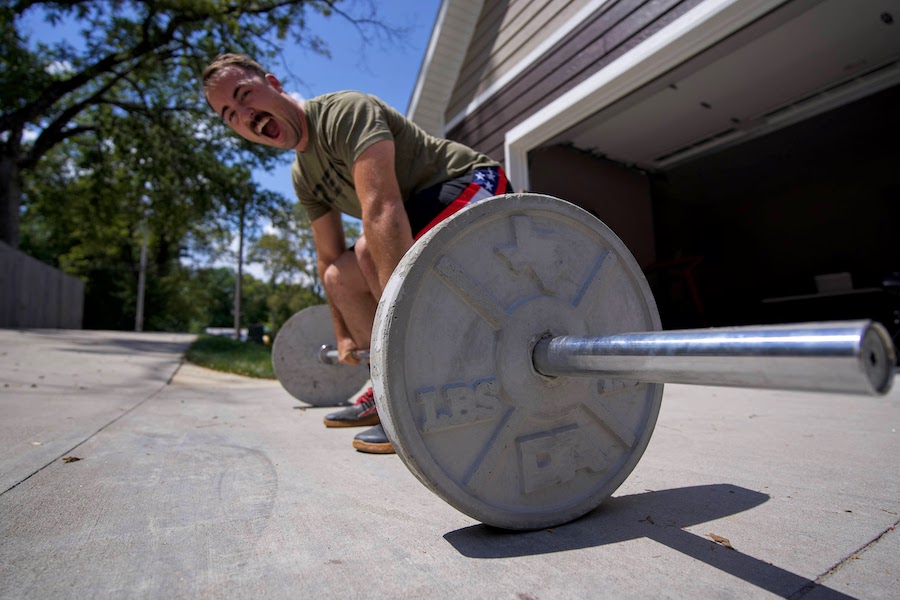
Want more stability work but don’t own a set of dumbbells? A barbell can easily take care of that! Stick a barbell in a landmine or wedge it in the corner of a squat rack and you could do unilateral work for your shoulders (single shoulder presses), back workouts (rows), or even core work (landmine twists aka “spell-casters”). If you also struggle with front squats in the traditional sense (squat rack and barbell), you could easily take the end of the barbell in each hand and do some front squats with a barbell-loaded landmine!
RELATED: Barbell Exercises
Besides landmine work, you could use a barbell to do Pendlay rows, snatches, overhead presses, hip thrusts, and so much more. Barbells are incredibly versatile and are used in a variety of movements.
Dumbbell Exercise Movements
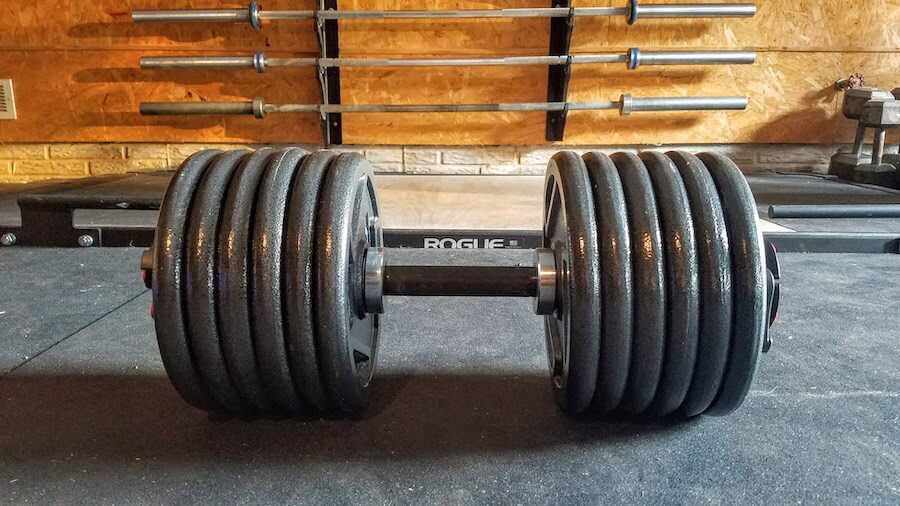
Dumbbells have their place as well for unique movements, so don’t completely dismiss them! A single dumbbell can be used in a variety of movements – goblet squats, renegade rows, clean and presses, swings, snatches, etc. Also, they are fantastic for unilateral work and improving grip strength and overall stability. Some useful exercises include suitcase deadlifts, single-leg deadlifts, farmer carries, split squats, single lateral raises, and more.
RELATED: Best Dumbbell Exercises
Exercise Variety
Dumbbells and barbells both provide for a broad variety of workouts. A barbell is more suited for large compound movements, but dumbbells allow you to isolate certain muscles more easily. Dumbbells may be used for most workouts that would normally need a barbell. A few exercises include:
- Dumbbell squat
- Reverse Lunges
- Wrist curls
- Dumbbell bicep curls
- Dumbbells rows
- Dumbbell bench press
- Arnold press
- and more!
Barbells Vs. Dumbbells FAQs
Do dumbbells build more muscle than barbells?
When opposed to dumbbell workouts, barbell exercises involve fewer stabilizer muscles. That’s why, relative to the combined weight of two dumbbells, most people can lift more using a barbell. When opposed to dumbbells, barbells enable bodybuilders to lift more weight.
RELATED: Dumbbell Leg Workout
What is the difference between dumbbells and barbells?
Even though you can do certain workouts with dumbbells, others are meant to be done with a barbell. Another benefit of barbells is that they allow you to lift greater weight. Because you handle the bar with two hands rather than just one, a barbell can weigh more heavily than a dumbbell and is safer to use with higher weights.
What are the benefits of buying dumbbells instead of barbells?
The Advantages of Using Dumbbells Dumbbells provide more strength and flexibility (ROM) and mobility than a barbell exercise, whether you use one or two at a time.


